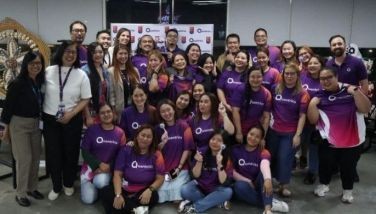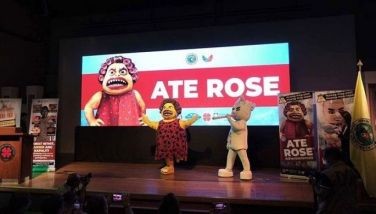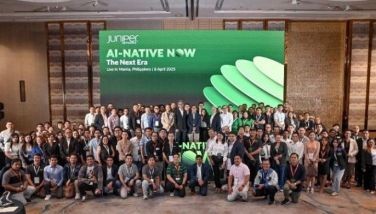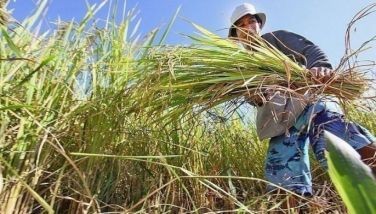CATFISH
April 30, 2006 | 12:00am
CARMEN, North Cotabato – It seemed for quite sometime that the strife in Mindanao would never end. But it did, and when it finally came to an end Moro National Liberation Front (MNLF) commanders laid their guns down and started on a new crusade to rebuild their lives.
Datucon Aliudin, a former MNLF commander, went into corn farming in 2002. He and the cooperative he leads, the Lumayon Village Farmers Association of Barangay Manarapan, received technical and financial assistance from the Livelihood Enhancement and Peace (LEAP), a program of the Growth with Equity in Mindanao (GEM) that is funded by the United States Agency for International Development (USAID).
Late last year, the group diversified into catfish and tilapia production through GEM’s Targeted Commodity Expansion Program (TCEP). Their first harvest from just two ponds yielded P18,000 and this was used to build eight more small ponds now stocked with catfish and tilapia fingerlings.
"There has definitely been a big change in our lives since the peace agreement. We got into corn farming because most of us were corn farmers before the all-out war. But then corn farming is not so profitable, the inputs are high but the prices are low. So we decided to supplement our income by going into fishpond production. It’s not as tedious and the returns are higher," says Aliudin in Tagalog.
Assisted by TCEP fishery experts, the cooperative learned all the rudiments of tilapia and catfish farming — from designing the pond, feeding to harvesting, water pond management and draining of ponds.
Part of the assistance is linking them with local buyers.
"Dealing with buyers is very important for us because we learn how to market our product and give value to our product. In the process, we are also expanding our network and are getting in touch with more potential buyers, not just from nearby towns, but in areas that have bigger requirements. We are also able to program our stocking of ponds depending on the volume that our buyers want, that way, we keep prices of the fish stable and assure us of profit," says Aliudin.
About 30 minutes from Bgy, Manarapan, another former MNLF combatant, Tamson Antolin and leader of the Sitio Bulakan Multi-Purpose Cooperative is discussing plans with some of their 21 members to expand their fishpond production.
"It’s good to be talking about livelihood rather than staging another ambush or attack," stresses Antolin.
Just like Aliudin, Antolin was devastated when he saw what happened to his home after the fighting was over. With so much moving about and torching of houses, there was so little to work with. But he and his men, all with growing children, had to start somewhere. They planted rice and corn, learning new planting techniques through the LEAP program. Later, the cooperative added catfish production, taking advantage of technical help provided under the TCEP program.
After a series of catfish production technology workshops for former combatants, the co-op designed and built an 800-square-meter pond and stocked it with 5,000 catfish fingerlings. The profit from the first harvest encouraged the group to construct more ponds and buy more fingerlings.
Antolin said their neighbors were impressed at how the project has enabled members to send back their children to school while also affording to little by little carry out house improvements and buying mostly electronic appliances. One of their neighbors, a guy in his mid 60s decided to put up a fishpond of his own. Antolin helped him design the pond and taught him all that he had to learn about catfish farming.
"He is happy that he is still working and making money at his age," says Antolin.
His own son, Tato Madali, recalls he bought his first cellphone from his share in the co-op’s earnings. These days he brandishes one of Nokia’s mid-priced handsets with a built in-camera. While putting off college for a while to focus on catfish farming, Madali who took up units in criminology now wants to return to school and take up education and be a teacher.
"My younger brother just finished high school, and I may join him in college," says Madali while his father nods and smiles approvingly.
The co-op’s profitable catfish farming venture has encouraged other rice and corn farmers to diversify into fish farming. There are now a total of 13 co-ops with about 350 members in this province, Sultan Kudarat and Maguindanao engaged in catfish and tilapia farming.
There is indeed a great potential for growth. Adiulin says fishpond production requires minimum capital, the major expense is in buying feeds but the returns are significant. A typical 10 meter by 20 meter by 3.5 meter pond with a stocking density of 10 pieces of tilapia fingerlings per cubic meter can yield about 1,920 kilos and could earn a net of P18,000 to P20,000 a year per farmer. In these three provinces in Central Mindanao, production is projected to reach 240 metric tons per year worth P14 million with an annual net income of P6 million.
"This project gives us hope. In our case, this is the first time that any agency has bothered to come to us and find out what we want to do. We don’t need just financial assistance, we also need more technical assistance so that we could start something sustainable and not just rely on dole-outs," says Adiulin.
Datucon Aliudin, a former MNLF commander, went into corn farming in 2002. He and the cooperative he leads, the Lumayon Village Farmers Association of Barangay Manarapan, received technical and financial assistance from the Livelihood Enhancement and Peace (LEAP), a program of the Growth with Equity in Mindanao (GEM) that is funded by the United States Agency for International Development (USAID).
Late last year, the group diversified into catfish and tilapia production through GEM’s Targeted Commodity Expansion Program (TCEP). Their first harvest from just two ponds yielded P18,000 and this was used to build eight more small ponds now stocked with catfish and tilapia fingerlings.
"There has definitely been a big change in our lives since the peace agreement. We got into corn farming because most of us were corn farmers before the all-out war. But then corn farming is not so profitable, the inputs are high but the prices are low. So we decided to supplement our income by going into fishpond production. It’s not as tedious and the returns are higher," says Aliudin in Tagalog.
Assisted by TCEP fishery experts, the cooperative learned all the rudiments of tilapia and catfish farming — from designing the pond, feeding to harvesting, water pond management and draining of ponds.
Part of the assistance is linking them with local buyers.
"Dealing with buyers is very important for us because we learn how to market our product and give value to our product. In the process, we are also expanding our network and are getting in touch with more potential buyers, not just from nearby towns, but in areas that have bigger requirements. We are also able to program our stocking of ponds depending on the volume that our buyers want, that way, we keep prices of the fish stable and assure us of profit," says Aliudin.
About 30 minutes from Bgy, Manarapan, another former MNLF combatant, Tamson Antolin and leader of the Sitio Bulakan Multi-Purpose Cooperative is discussing plans with some of their 21 members to expand their fishpond production.
"It’s good to be talking about livelihood rather than staging another ambush or attack," stresses Antolin.
Just like Aliudin, Antolin was devastated when he saw what happened to his home after the fighting was over. With so much moving about and torching of houses, there was so little to work with. But he and his men, all with growing children, had to start somewhere. They planted rice and corn, learning new planting techniques through the LEAP program. Later, the cooperative added catfish production, taking advantage of technical help provided under the TCEP program.
After a series of catfish production technology workshops for former combatants, the co-op designed and built an 800-square-meter pond and stocked it with 5,000 catfish fingerlings. The profit from the first harvest encouraged the group to construct more ponds and buy more fingerlings.
Antolin said their neighbors were impressed at how the project has enabled members to send back their children to school while also affording to little by little carry out house improvements and buying mostly electronic appliances. One of their neighbors, a guy in his mid 60s decided to put up a fishpond of his own. Antolin helped him design the pond and taught him all that he had to learn about catfish farming.
"He is happy that he is still working and making money at his age," says Antolin.
His own son, Tato Madali, recalls he bought his first cellphone from his share in the co-op’s earnings. These days he brandishes one of Nokia’s mid-priced handsets with a built in-camera. While putting off college for a while to focus on catfish farming, Madali who took up units in criminology now wants to return to school and take up education and be a teacher.
"My younger brother just finished high school, and I may join him in college," says Madali while his father nods and smiles approvingly.
The co-op’s profitable catfish farming venture has encouraged other rice and corn farmers to diversify into fish farming. There are now a total of 13 co-ops with about 350 members in this province, Sultan Kudarat and Maguindanao engaged in catfish and tilapia farming.
There is indeed a great potential for growth. Adiulin says fishpond production requires minimum capital, the major expense is in buying feeds but the returns are significant. A typical 10 meter by 20 meter by 3.5 meter pond with a stocking density of 10 pieces of tilapia fingerlings per cubic meter can yield about 1,920 kilos and could earn a net of P18,000 to P20,000 a year per farmer. In these three provinces in Central Mindanao, production is projected to reach 240 metric tons per year worth P14 million with an annual net income of P6 million.
"This project gives us hope. In our case, this is the first time that any agency has bothered to come to us and find out what we want to do. We don’t need just financial assistance, we also need more technical assistance so that we could start something sustainable and not just rely on dole-outs," says Adiulin.
BrandSpace Articles
<
>
- Latest
Latest
Latest
March 26, 2025 - 3:46pm
By Dominique Nicole Flores | March 26, 2025 - 3:46pm
February 28, 2025 - 11:26am
By Dominique Nicole Flores | February 28, 2025 - 11:26am
February 24, 2025 - 6:28pm
By Dominique Nicole Flores | February 24, 2025 - 6:28pm
February 19, 2025 - 7:28pm
By Dominique Nicole Flores | February 19, 2025 - 7:28pm
January 10, 2025 - 11:00am
January 10, 2025 - 11:00am
Recommended






























